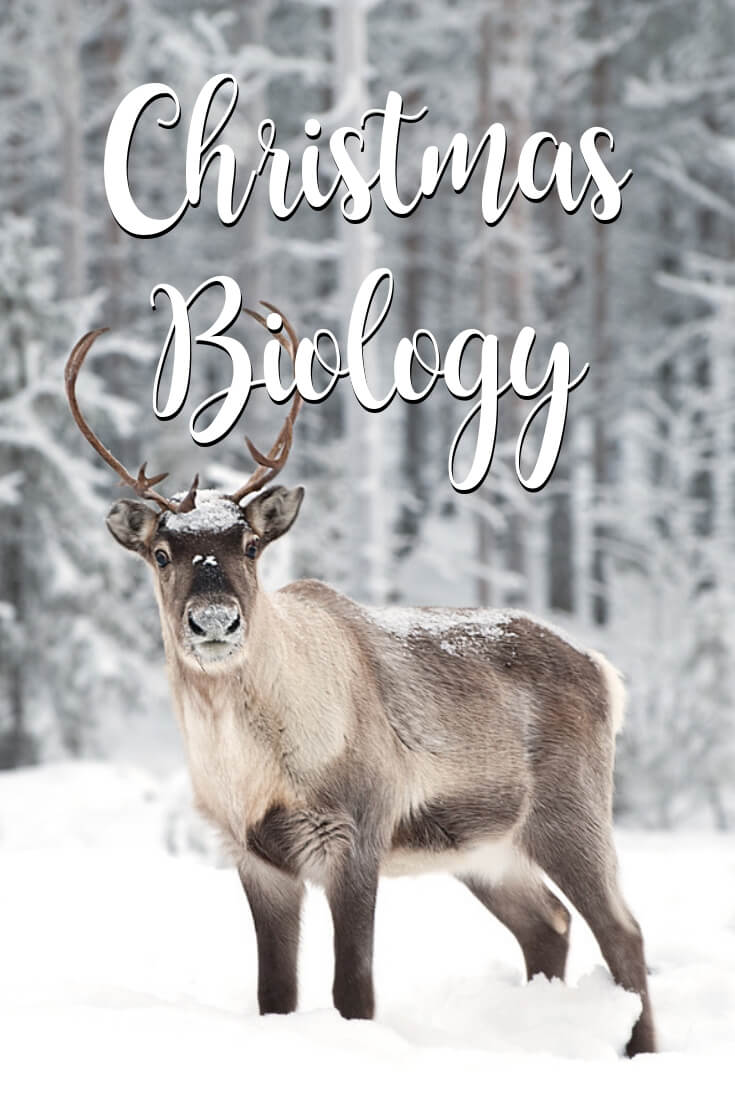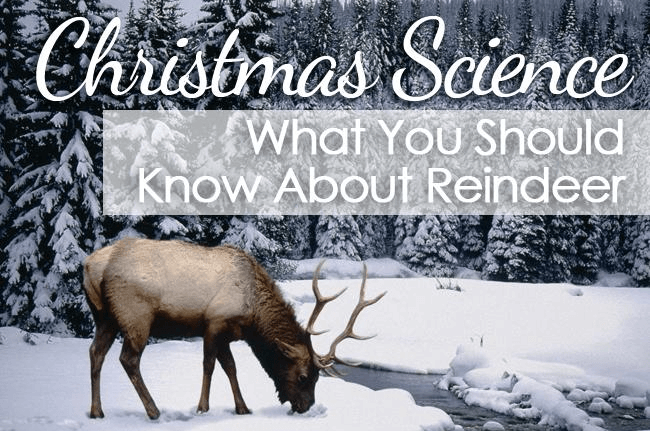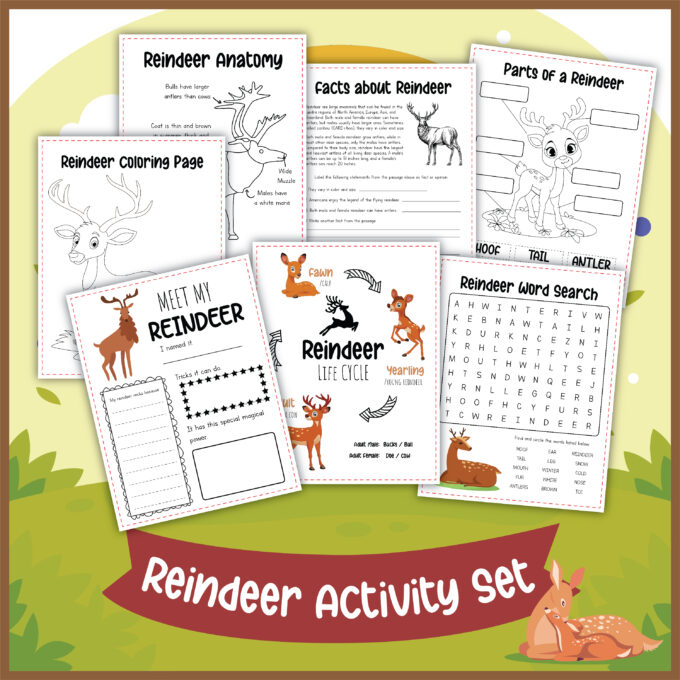Yes! Reindeer are real and these gorgeous mammals don’t just live at the North Pole. We are counting down with a little bit of Christmas biology, specifically fun reindeer facts. You can learn more about these interesting furry animals as you countdown to Christmas!
FUN FACTS ABOUT REINDEER FOR KIDS

REAL CHRISTMAS REINDEER
Have you ever seen a real Christmas reindeer? We have! Not in the wild, of course… But it’s still a magical experience, just the same.
We thought we would share some interesting facts about these fantastic animals. How do they live in some of the coldest parts of the world? Read on to find out more…
FUN FACTS ABOUT REINDEER
Check out some interesting facts about reindeer below. You can even show your kids the beauty of real reindeer with the Reindeer Cam links below.
- In December, you can watch live reindeer cams at ReindeerCam.com (Caledonia, MI).
WHAT DO REINDEER EAT?
- Reindeer’s favorite foods are grass, moss, herbs, and berries.
WHAT TYPE OF ANIMAL ARE REINDEER?
- Reindeer and caribou are the same species but different subspecies. They are closely related to deer, elk, and moose. While there are many subtle differences between reindeer and caribou, reindeer are domesticated, and caribou are wild.
- Domesticated raised reindeer are very friendly animals. You can hand feed them, train them to pull sleds, wagons, and the like!
YOU MAY ALSO LIKE: Reindeer Ornaments
WHERE DO REINDEER LIVE?
- Reindeer live in very large packs of sometimes thousands in Arctic forests. See our Biomes of the World.
- Packs of reindeer are often hunted by wolves, polar bears, brown bears, and even sharks! Reindeer are really fast and migrate in group of hundreds to thousands, so they are not easy to catch.

Interesting facts about reindeer…
DID YOU KNOW?
- A reindeer’s hooves change with the seasons! In the soft, summer ground the hooves also become softer and more spongy. In the freezing, icy winter, the hooves harden and become sharper so that the edges can cut into the ice. These grooves prevent the reindeer from slipping on the ice and snow.
HOW DO REINDEER STAY WARM?
- Reindeers have a very thick coat made of two layers of fur. The bottom layer is woolly and the top layer is made of long, hollow hairs. See below for more ways that reindeer have adapted to harsh environments.
ALSO CHECK OUT: How Do Polar Bears Stay Warm?
REINDEER AS PETS?
- In the late 9th century, Ohthere of Hålogaland sent a letter to King Alfred the Great, in which he stated that he owned 600 domesticated reindeer, of which six were decoys that he used for catching more reindeer to bring into his herd.
YOU MAY ALSO LIKE: Rudolph Ornament
DO REINDEER HAVE ANTLERS?
- Unlike regular deer, both male and female reindeer grow antlers. The antlers look velvety because they are composed of a very blood-supply-rich material. Scientists are studying deer antlers to understand bone cancers better. Male and female reindeer shed their antlers in different seasons. These highly calciumated lost antlers are then consumed by rodents and other forest creatures.
For older kids, download this Reindeer Facts Word Search using words from the text above!
25 Quick Reindeer Facts for Kids
- Reindeer are also known as caribou in North America.
- They are native to the Arctic regions of North America, Europe, and Asia.
- Reindeer are well adapted to cold climates and can be found in Alaska, Canada, Scandinavia, and Russia.
- They have a thick coat of fur that helps keep them warm in freezing temperatures.
- Reindeer are herbivores, which means they only eat plants.
- Their favorite foods include grass, lichen, moss, and shrubs.
- Reindeer are known for their long, antlered heads, usually found on males or bulls.
- Their antlers can grow up to 51 inches (130 cm) long!
- Reindeer are not the same as moose, which are larger and have different antler shapes.
- These animals are social creatures and often travel in herds.
- Reindeer are excellent swimmers and can cross rivers and lakes with ease.
- They can also run fast, reaching up to 50 miles per hour (80 km/h).
- In the winter, reindeer use their hooves to dig through the snow to find food.
- Reindeer are the only deer species where both males and females grow antlers.
- Female reindeer, or cows, give birth to one calf at a time.
- The babies are born in late spring or early summer.
- Reindeer calves can stand and walk within just a few hours of being born.
- Their hooves change in the summer to help them walk on soft, marshy ground.
- In the winter, their hooves harden and become concave, allowing them to walk on snow.
- Reindeer are known for their migration patterns, moving to different areas for food.
- These animals have special adaptations, like a keen sense of smell, to help them find food in the snow.
- They have a four-chambered stomach, which allows them to digest their plant-based diet effectively.
- Reindeer are an important part of the traditional cultures of the indigenous peoples of the Arctic.
- In some cultures, reindeer are used for transportation and as a source of food, clothing, and tools.
- Reindeer are also famous for pulling Santa’s sleigh on Christmas Eve, according to popular folklore.
Free Printable Reindeer Facts Activity Pack

Adaptation Facts About Reindeer
Reindeer have developed several remarkable adaptations to thrive in harsh Arctic environments. These adaptations help them cope with extreme cold, deep snow, and limited food resources. Here are some ways in which reindeer have adapted:
Thick Insulating Fur: Reindeer have a dense and warm fur coat that helps them retain body heat. Their fur consists of an outer layer of guard hairs and an insulating layer of underfur.
Layered Hooves: Reindeer have hooves that adapt to the season. In the summer, their hooves are concave, which allows them to grip on soft and marshy ground. In the winter, their hooves harden, providing traction on snow and ice.
Rumen Stomach: Reindeer have a specialized four-chambered stomach that allows them to digest tough, fibrous plant material efficiently. They can extract nutrients from lichens, mosses, and other plants that many other animals cannot digest.
Migration: Reindeer are migratory animals. They travel to different areas throughout the year to find food. This strategy helps them avoid overgrazing and depletion of resources in a particular area.
Snow Shoveling: In winter, reindeer use their hooves to dig through deep snow to access food. They are skilled at finding and exposing hidden vegetation.
Efficient Grazing: Reindeer have a keen sense of smell that helps them locate buried food sources beneath the snow. They can detect scents from great distances.
Large, Broad Feet: Their large, broad hooves act like snowshoes, allowing them to walk on top of deep snow and prevent sinking in. This is especially useful when foraging for food in winter.
Social Behavior: Reindeer often form herds, which provides protection from predators and the added warmth of many bodies huddled together.
Antlers: The antlers of reindeer serve various purposes, including defense against predators and competition with other reindeer for access to mates and resources.
Warm Blood: Reindeer have a high metabolic rate and can generate body heat, which helps them stay warm in extreme cold.
Swimming Skills: Reindeer are excellent swimmers and can cross rivers and lakes when they need to. This skill is essential for their migration patterns.
These adaptations have evolved to help reindeer survive and thrive in the challenging environments of the Arctic and subarctic regions. They are a remarkable example of nature’s ability to adapt to extreme conditions.
Printable Christmas STEM Project Pack
200+ PAGES OF HOLIDAY THEME STEAM, STEM, Science, and Art!
- 25+ Christmas theme science and STEM activities with printable sheets, instructions, and useful information all using easy-to-source materials perfect for limited-time needs. Includes a holiday theme engineering pack with fun, problem-based challenges for kids to solve! NEW observation sheets included.
- Try a Santa’s Letter airplane challenge or take the gingerbread house-building challenge!
- Explore the five senses with a specially designed Santa’s Lab pack.
- Try a mini nature study with your favorite type of Christmas tree.
- Try your hand at building shapes with gumdrop structure challenge cards or build shapes with jingle bells. Or try the Christmas-themed paper chain challenge!
- Christmas Screen-free Coding activities include algorithm games, binary code ornaments, and more!
- Explore 6+ Christmas Art Projects with famous artist-inspired activities that combine art history, process art techniques, and more with simple to-do ideas.















3 Comments
Comments are closed.